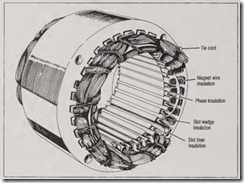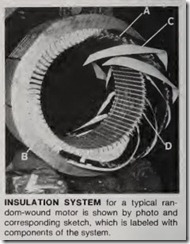Know insulation systems for longer motor life
By WILLIAM I. KOLOVRAT and VELLO NOLVAK
INSULATION is the heart of the elec tric motor. It is a major element that has the greatest effect on motor life and its maintenance history. When insulation fails, the motor fails. Insula tion is the one component that under goes more design changes than any other part of the motor, especially today when equipment sizes seem to be shrinking and motors are subjected to higher operating temperatures.
In addition, the reduction of energy costs, improved productivity, and reli ability of operation have become of paramount importance to today’s facil ities managers. These electrical people, for whom cost and continuity of applied power are particularly impor tant, are now taking a closer look at the key element in the performance and dependability of the motors and generators-the insulation system. Therefore, it has become vital that chief electricians, plant electrical engi neers, and other facilities electrical people obtain a good knowledge of motor insulation to aid in the estab lishment of an effective maintenance program and help make the proper insulation specification for a particular application.
The primary functions of a motor’s insulation are to separate the various electrical components from each other and to protect itself and the compo nents from such environme ntal con tamination factors· as dirt, chemicals, and other destructive forces-including heat and vibration.
The type of insulation system required depends upon not only the environment in which it operates, but also the characteristics of the insulating materials.
The following checklist of causes and effects will help determine the insulation system needed.
• High ambient temperature (temperature of air surrounding motor, higher than 40°C or 104°F) causes deterioration and accelerated aging. It can also reduce viscosity of grease in bearings, thus reducing the ‘value of lubrication.
• Corrosive agents (chemicals) eat away at insulation and exposed metal parts such as air-gap surfaces, bear ings and shaft, eventually causing mal function.
• Abrasive agents (sand, filings, dust) erode protective coatings as well as exposed surfaces, scoring critical bear ings and wearing commutators and rings.
• Blanketing agents (dust, dirt, snow) can coat critical motor components, clogging air vents and passages. Heat dissipation is thereby reduced.
• Moisture (high humidity, rain) causes shorting of windings as well as rusting of metal parts.
• Mechanical abuse (shock, vibration) causes mounting feet, frames, shafts and brackets to break. It also causes chattering brushes, fatigued terminal connections, and damaged bearings.
• High-altitude operation (more than 3300 ft above sea level) causes exces sive heat. Thinner air has less cooling ability.
Insulation system components
Major elements of a typical insula tion system for an AC random-wound motor are shown in the accompanying sketch. The two most significant com ponents of the system are the turn to-turn or magnet-wire insulation (A) than 40°C or 104oF) causes deteriora and the phase-to-ground or slot-liner insulation (B). The magnet-wire insu lation separates individual wires in each coil. In smaller motors this insu lation is usually enamel; in larger, form-wound motors, the coils are taped.
The slot liner insulates between the windings as a whole and the “ground,” or metal parts, of the motor. This can be a composite layered sheet material of polyester mat/polyester film/poly ester mat, which provides both dielectric and mechanical protection.
Phase-to-phase insulation (C) sepa rates adjacent coils in the different phase groups. This is a separate flexi ble sheet on smaller motors but is not required on larger form-wound motors, where tape performs this function.
The tie cord (E) secures the coil winding end turns.
The wound stator can be dipped or vacuum-impregnated and then baked with an electrical varnish to provide adhesion, heal any wire damage from winding and handling, provide mois ture and chemical resistance, and gen erally upgrade the insulation system’s overall performance.
At about 500 hp, winding construc tion of AC motors changes from round wire, random-wound coils to rectangu lar-wire, form-wound coils. Like the conductors in the random-wound mo tor, the rectangular copper conductors are coated with enamel. They are then insulated with glass, aramid fiber paper, or mica paper.
The slot section of the coi I is wrapped with mica paper, and the end turns, or diamond sections, of the coil are insulated with mica tape. These sections are overwrapped with armor ing glass or polyester glass tape.
In the stator of a large A C motor, varnished glass may be used as the slot cell for added protection during wind ing. The form-wound coils are then placed into the stator. Wedges may be of glass polyester, canvas phenolic, or other high-pressure laminate. A poly ester felt material is used for the braces between the diamond sections of the coil. These braces make the end turns rigid to withstand the mechanical forces of start-up and protect against short-circuit conditions.
The completely wound, wedged and braced stator may be varnish-dipped or vacuum-pressu re impregnated.
Temperature ratings
Motor insulation is rated sequential ly by the thermal class letters A, B, F and H, each letter directly correspond ing to a temperature index expressed in degrees centigrade and indicating maximum operating temperature.
For example, a Class B motor has a maximum allowable operating temper ature, or hot spot, of 13o·c.
This hot-spot temperature, which is the temperature at the center of the motor coil, is the sum of all the factors that produce heat in the motor wind ing. These include ambient tempera ture, motor rise temperature by resist ance, and the hot-spot allowance (see accompanying table).
Some of the various insulating materials and their applications found in each classification are:
• Class A- Rag paper or polyester film. This class is used for fractional horsepower applications: electric drills, vacuum cleaners, small appliances.
• Class B-Polyester mat/film/mat a 3-ply composite can be saturated with polyester or epoxy resins. Consid ered the NEMA standard, most off the-shelf motors have this insulation for HV A C application (refrigeration and air conditioning) and for fraction al-horsepower motors.
• Class F-Polyester composite and aramid fiber paper or laminates of aramid paper. Many more motors today are using this insulation class to prolong operating life. Used for indus trial applications (process lines, pumps, compressors and fans).
Class H-Composites such as aram id fiber paper and polyester film, polyimide film, or combinations of the foregoing materials. High-tempera ture, high-reliability applications for transportation industry (subway, peopie movers), heavy construction prod ucts and for high-ambient, high-alti- tude use .
Temperature is vital
Although mechanical and environ mental factors affect the life of a motor insulation system, the primary limiting force is heat. How long any given insu lating material will last depends on the degree and duration of heat to which it is exposed.
Electrical insulation is assumed to have a life expectancy of approxi mately 20 years if the motor is oper ated within specified (nameplate) lim its. To determine how long a motor insulation system will last in a particu lar application, the industry rule of thumb is: for every 1o·c increase in insulation temperature, its life is halved; and for every 1o·c decrease in temperature, its life is doubled .
Of course, other factors affect motor insulation life. For example, during motor start-up, as much as six times the normal current can be applied to the motor, producing more heat. While this is only a momentary surge through its windings and has little effect, if your motor is required to start many times each day or if frequent starts with an unusually heavy load are necessary, it would be wise to consider a better insulation system.
The motor user can be assured the stock motor he buys from a qualified salesperson or distributor is correct for the application specified. For example, for a motor operating in a typical plant where the air is relatively clean and dry and motor abuse is absent, a Class B or F insulation system in a standard off-the-shelf motor should be adequate . On the other hand, if the motor is required to work in the hot, dirty atmosphere of a mine, then clearly a more sophisticated system is needed .



